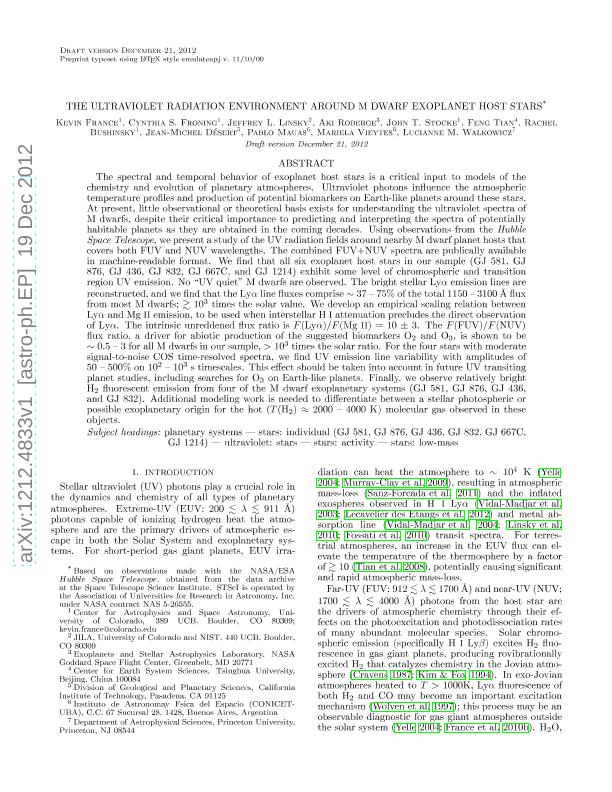Mostrar el registro sencillo del ítem
dc.contributor.author
France, Kevin
dc.contributor.author
Froning, Cynthia S.
dc.contributor.author
Linsky, Jeffrey L.
dc.contributor.author
Roberge, Aki
dc.contributor.author
Stocke, John T.
dc.contributor.author
Tian, Feng
dc.contributor.author
Bushinsky, Rachel
dc.contributor.author
Déser, Jean-Michel
dc.contributor.author
Mauas, Pablo Jacobo David

dc.contributor.author
Vieytes, Mariela Cristina

dc.contributor.author
Walkowicz, Lucianne M.
dc.date.available
2015-06-09T17:48:18Z
dc.date.issued
2013-02
dc.identifier.citation
France, Kevin; Froning, Cynthia S.; Linsky, Jeffrey L.; Roberge, Aki; Stocke, John T.; et al.; The Ultraviolet Radiation Environment around M dwarf Exoplanet Host Stars; IOP Publishing; Astrophysical Journal; 763; 149; 2-2013; 149-163
dc.identifier.issn
0004-637X
dc.identifier.uri
http://hdl.handle.net/11336/649
dc.description.abstract
The spectral and temporal behavior of exoplanet host stars is a critical input to models of the chemistry and evolution of planetary atmospheres. Ultraviolet photons influence the atmospheric temperature profiles and production of potential biomarkers on Earth-like planets around these stars. At present, little observational or theoretical basis exists for understanding the ultraviolet spectra of M dwarfs, despite their critical importance to predicting and interpreting the spectra of potentially habitable planets as they are obtained in the coming decades. Using observations from the Hubble Space Telescope, we present a study of the UV radiation fields around nearby M dwarf planet hosts that covers both far-UV (FUV) and near-UV (NUV) wavelengths. The combined FUV+NUV spectra are publicly available in machine-readable format. We find that all six exoplanet host stars in our sample (GJ 581, GJ 876, GJ 436, GJ 832, GJ 667C, and GJ 1214) exhibit some level of chromospheric and transition region UV emission. No "UV-quiet" M dwarfs are observed. The bright stellar Lyα emission lines are reconstructed, and we find that the Lyα line fluxes comprise ∼37%-75% of the total 1150-3100 Å flux from most M dwarfs; ≳103 times the solar value. We develop an empirical scaling relation between Lyα and Mg II emission, to be used when interstellar H I attenuation precludes the direct observation of Lyα. The intrinsic unreddened flux ratio is F(Lyα)/F(Mg II) = 10 ± 3. The F(FUV)/F(NUV) flux ratio, a driver for abiotic production of the suggested biomarkers O2 and O3, is shown to be ∼0.5-3 for all M dwarfs in our sample, >103 times the solar ratio. For the four stars with moderate signal-to-noise Cosmic Origins Spectrograph time-resolved spectra, we find UV emission line variability with amplitudes of 50%-500% on 102-103 s timescales. This effect should be taken into account in future UV transiting planet studies, including searches for O 3 on Earth-like planets. Finally, we observe relatively bright H 2 fluorescent emission from four of the M dwarf exoplanetary systems (GJ 581, GJ 876, GJ 436, and GJ 832). Additional modeling work is needed to differentiate between a stellar photospheric or possible exoplanetary origin for the hot (T(H2) ≈ 2000-4000 K) molecular gas observed in these objects.
dc.format
application/pdf
dc.language.iso
eng
dc.publisher
IOP Publishing

dc.rights
info:eu-repo/semantics/openAccess
dc.rights.uri
https://creativecommons.org/licenses/by-nc-sa/2.5/ar/
dc.subject
PLANETARY SYSTEMS
dc.subject
STARS: ACTIVITY
dc.subject
STARS: INDIVIDUAL (GJ 581, GJ 876, GJ 436, GJ 832, GJ 667C, GJ 1214)
dc.subject
STARS: LOW-MASS
dc.subject
ULTRAVIOLET: STARS
dc.subject.classification
Astronomía

dc.subject.classification
Ciencias Físicas

dc.subject.classification
CIENCIAS NATURALES Y EXACTAS

dc.title
The Ultraviolet Radiation Environment around M dwarf Exoplanet Host Stars
dc.type
info:eu-repo/semantics/article
dc.type
info:ar-repo/semantics/artículo
dc.type
info:eu-repo/semantics/publishedVersion
dc.date.updated
2016-03-30 10:35:44.97925-03
dc.journal.volume
763
dc.journal.number
149
dc.journal.pagination
149-163
dc.journal.pais
Reino Unido

dc.journal.ciudad
Londres
dc.description.fil
Fil: France, Kevin. State University of Colorado at Boulder; Estados Unidos
dc.description.fil
Fil: Froning, Cynthia S.. State University of Colorado at Boulder; Estados Unidos
dc.description.fil
Fil: Linsky, Jeffrey L.. State University of Colorado at Boulder; Estados Unidos
dc.description.fil
Fil: Roberge, Aki. Nasa Goddard Space Flight Center; Estados Unidos
dc.description.fil
Fil: Stocke, John T.. State University of Colorado at Boulder; Estados Unidos
dc.description.fil
Fil: Tian, Feng. Tsinghua University; China
dc.description.fil
Fil: Bushinsky, Rachel. State University of Colorado at Boulder; Estados Unidos
dc.description.fil
Fil: Déser, Jean-Michel. California Institute of Technology; Estados Unidos
dc.description.fil
Fil: Mauas, Pablo Jacobo David. Consejo Nacional de Investigaciones Científicas y Técnicas. Oficina de Coordinación Administrativa Ciudad Universitaria. Instituto de Astronomía y Física del Espacio(i); Argentina
dc.description.fil
Fil: Vieytes, Mariela Cristina. Consejo Nacional de Investigaciones Científicas y Técnicas. Oficina de Coordinación Administrativa Ciudad Universitaria. Instituto de Astronomía y Física del Espacio(i); Argentina
dc.description.fil
Fil: Walkowicz, Lucianne M.. University of Princeton; Estados Unidos
dc.journal.title
Astrophysical Journal

dc.relation.alternativeid
info:eu-repo/semantics/altIdentifier/doi/http://dx.doi.org/10.1088/0004-637X/763/2/149
dc.relation.alternativeid
info:eu-repo/semantics/altIdentifier/url/http://iopscience.iop.org/0004-637X/763/2/149/
Archivos asociados
